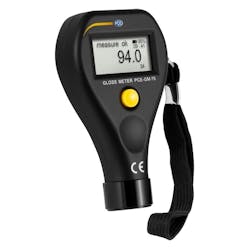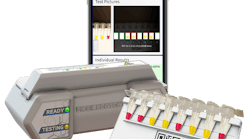Gloss Meters/Gloss Testers from PCE Instruments (PCE) measure gloss units of painted, coated and shiny surfaces typically from 20-degree, 60-degree and 85-degree reflective angles. When choosing the correct angle for gloss measurement, it is important to consider the gloss range of the surface. A gloss meter can be used on smooth, treated or untreated surfaces such as stone, wood, laminates, floors and more. Thus, a gloss meter is a versatile measuring tool used in a variety of practical applications.
Why measure gloss with a gloss meter?
A glossy package adds perceived value to a product. In fact, it has been shown that the gloss level of a product has as much psychological impact on a consumer as its color. However, on food packaging, gloss does more than just maximize customer appeal. Gloss plays a vital role in ensuring consumer safety. For example, if the gloss level of an ultraviolet varnish drops during the production of food product packaging, there could be curing problems. Poorly cured inks, paints and coatings can rub, chip and flake off of the packaging to contaminate the food within. But by monitoring food packaging gloss levels during production, using a gloss meter, problems such as these can be detected early to avoid the cost of recoating or recalling.
In addition to packaging, a gloss meter can be used on manufactured materials, components and the products themselves. A gloss meter or gloss tester provides manufacturing and quality control professionals with a quick and easy way to evaluate the surface characteristics of their products. A gloss tester or gloss meter is especially handy for manufacturers who produce products with a big lot size. When large lot sizes are produced, it is essential to use a gloss meter to verify that the colors and gloss are the same on every single product. This is a common expectation from customers. A number of factors can affect the gloss of a surface, such as coating amount and type, polishing smoothness, and substrate quality. By using a gloss meter and employing good quality control practices, you can ensure these variables don’t negatively impact your customers’ perception of your product.
Gloss variation can be assessed quickly, easily and accurately using a professional gloss meter from PCE Instruments (PCE). Thousands of manufacturing and quality control professionals rely on PCE’s digital gloss testers to evaluate the standards and safety of their products. Each gloss meter offered by PCE is compact, user friendly and designed to take gloss measurements on the spot. This makes PCE’s gloss testers especially handy for checking gloss levels on the production floor or even in the field.
How to measure gloss
To choose the right gloss meter for your application, you will need to evaluate whether the surface you’re looking to test is high gloss, medium (semi) gloss or low gloss. You will also want to take into consideration the type of material to be tested by the gloss meter. After determining these characteristics, you may use the following guidelines to identify the angle needed to obtain the most accurate measurement:
20 ° = high gloss coatings, plastics, brightened metal and similar materials60 ° = medium (semi) gloss coatings, plastics, brightened metal and similar materials85 ° = low gloss coatings, plastics, brightened metal and similar materials
A gloss meter uses a method of measurement to determine the intensity of a light reflected by a surface to be tested. The measurement values determined by this method with a gloss tester under a fixed angle of incidence act as reference values which are relative to the gloss of the surface. The measuring head of the gloss meter which is adapted to the angle of incidence (20 °, 60 °, 85 °) is placed on the material surface and the gloss value can be read out at the scale of the gloss meter. The gloss meter’s measuring head must be calibrated and a statistically sufficient quantity of data must be determined. The angle of measurement is predetermined by the gloss of the sample to be measured with the gloss meter..




